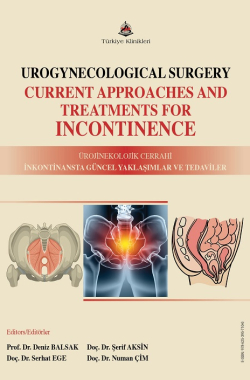FERTILITY AND UROGYNECOLOGICAL SURGERY
Çağcil Yetim1 Merve Demir2
1Medicana Ataköy Hospital, Department of Gynecology and Obstetrics, İstanbul, Türkiye
2Bahçeşehir University, Faculty of Medicine, Department of Gynecology and Obstetrics, İstanbul, Türkiye
Yetim Ç, Demir M. Fertility and Urogynecological Surgery. In: Balsak D, Çim N, Ege S editors. Urogynecological Surgery Current Approaches and Treatments for Incontinence. 1st ed. Ankara: Türkiye Klinikleri; 2025. p.91-101.
ABSTRACT
Pelvic floor disorders, particularly pelvic organ prolapse (POP) and urinary incontinence, are common in women of reproductive age and often necessitate surgical management. Beyond their impact on quality of life, these conditions and their treatments have important implications for fertility and pregnancy outcomes. This chapter provides a comprehensive overview of the available urogynecological surgical techniques with a focus on uterine-sparing procedures and their relevance for women planning future pregnancies.
For POP, uterus-preserving operations such as sacrospinous ligament hysteropexy, uterosacral ligament hysteropexy, and abdominal sacrohysteropexy have been increasingly adopted as alternatives to hysterectomy. Evidence suggests that native tissue repairs, except for the Manchester procedure, are associated with favorable fertility preservation and obstetric outcomes. In contrast, techniques involving cervical amputation or mesh implants raise concerns regarding cervical stenosis, premature rupture of membranes, impaired uteroplacental blood flow, or mesh-related pelvic pain during pregnancy. Although successful pregnancies have been reported after these procedures, complications and recurrence risks underscore the importance of individualized surgical planning.
Manchester procedure, while uterus-sparing, has been linked to reduced fertility rates and increased pregnancy loss, mainly due to cervical amputation. Similarly, sacrohysteropexy using synthetic mesh, though effective in restoring pelvic support, has been associated with unique complications during gestation, such as pelvic pain or surgical difficulties during cesarean delivery. Consequently, non-mesh uterine-preserving approaches are generally recommended for women who desire future childbearing.
Urinary incontinence surgeries also warrant consideration in this context. Midurethral slings (MUS), currently the gold standard for stress urinary incontinence, have been shown to maintain continence without major obstetric complications when pregnancy occurs afterward. Available data suggest that a single pregnancy following MUS does not significantly increase the recurrence of incontinence, though multiple pregnancies may pose a greater risk. Retropubic colposuspension, while less commonly performed in the modern era, has similarly demonstrated acceptable safety profiles in subsequent pregnancies.
Overall, current literature emphasizes that uterus-sparing native tissue procedures—excluding the Manchester operation—are the safest options for preserving reproductive potential in women with POP. Additionally, appropriately timed incontinence surgery, particularly MUS, appears compatible with future pregnancies. Tailoring surgical strategies to patients’ fertility goals is essential to optimize both pelvic support and reproductive outcomes.
Keywords: Pelvic organ prolapse; Fertility; Pregnancy; Uterine-sparing surgery; Urinary incontinenc; Midurethral sling; Sacrohysteropexy
Kaynak Göster
Referanslar
- North American Menopause Society. The 2021 position statement on hormone therapy. Menopause. 2021;28(9):973997.
- International Menopause Society. Global consensus statement on menopausal hormone therapy. Climacteric. 2022;25(1):1-15.
- Demirtürk F. Investigation of pelvic floor muscle strength and affecting factors in various age periods. Contemporary Medical Journal. 2017;7(3):254-264. [Crossref]
- Uysal MF. The effects of Pilates exercises on pelvic floor, balance, posture, and quality of life in postmenopausal women [master's thesis]. Bolu: Abant İzzet Baysal University; 2016.
- Rossouw JE, Anderson GL, Prentice RL, et al. Risks and benefits of estrogen plus progestin in healthy postmenopausal women: Principal results from the Women's Health Initiative randomized controlled trial. JAMA. 2002;288(3):321-333. [Crossref] [PubMed]
- Lethaby A, Ayeleke RO, Roberts H. Local oestrogen for vaginal atrophy in postmenopausal women. Cochrane Database Syst Rev. 2016;(8): CD001500. [Crossref]
- Bo K, Hilde G. Postmenopausal women and pelvic floor muscle training: Scientific evidence and clinical implications. Int Urogynecol J. 2016;27(4):567-569.
- Özbek E. Common urological problems in menopause.
- Coşkuner Avcı A. Pelvic floor functions in postmenopaus al women [specialization thesis]. Istanbul: Health Sciences University; 2024.
- Mayo Clinic. Hormone therapy: Is it right for you? Mayo Clinic website.
- National Institute for Health and Care Excellence (NICE). Urinary incontinence and pelvic organ prolapse in women: Management. NICE guideline [NG123]. 2019.
- World Health Organization. Global health estimates. 2022.
- Yıldırır A, Yılmaz MB, Oto A. The effects of hormone replacement therapy on the cardiovascular system. Turkish Archives of Cardiology. 2004;32(1):17-24.
- Berghmans B, Hendriks E, Bernards A, et al. Conservative treatment of stress urinary incontinence in women: A systematic review of randomized clinical trials. BJU Int. 2015;115(1):33-43.
- Luber KM. The definition, prevalence, and risk factors for stress urinary incontinence. Rev Urol. 2004;6(Suppl 3):S3S9.

